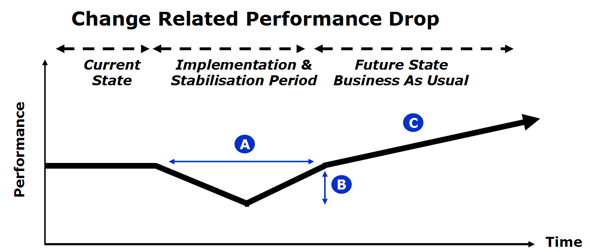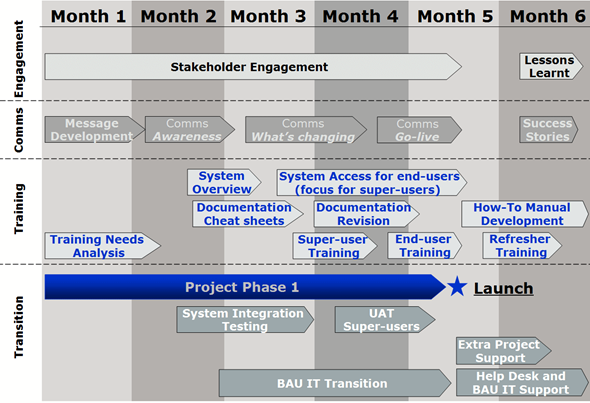Technology change projects are exciting, as they often aim to deliver a significant positive impact to customers, employees and the company’s bottom line. However they are also invariably challenging, with people, organisational and technical issues causing disruption to business-as-usual and a drop in performance. Professional change managers can mitigate this drop by applying four key levers.
 As shown in the diagram to the right, effective Change Management should decrease the duration of the drop in performance (A), the depth of the drop (B), and increase the benefits derived from successful implementation (C). Experienced IT project professionals know that a performance drop is unavoidable. The question is rather how we minimise it in both duration and magnitude.
As shown in the diagram to the right, effective Change Management should decrease the duration of the drop in performance (A), the depth of the drop (B), and increase the benefits derived from successful implementation (C). Experienced IT project professionals know that a performance drop is unavoidable. The question is rather how we minimise it in both duration and magnitude.
The cost of change management in an implementation typically takes one of two forms: either as a professional engagement supporting the change, or as consequential costs of not managing the change professionally. The latter is typically a significantly more expensive option – and often leads to belatedly invoking change management consulting to fix the damage caused.
It is necessary to commence a Change Management engagement by assessing the impact of the change to affected stakeholders. This information allows an assessment of stakeholder impacts, how they are impacted, and leads to a recommended engagement strategy and change interventions.
The 4 Levers
As shown in this diagram, there are 4 key levers in an IT change program: engagement, communication, training and transition. Let’s look at what each of these mean at a high level.

1. Stakeholder Engagement
This lever is all about business buy-in and acceptance of the IT Project, and ensuring that stakeholders are adequately engaged at the appropriate times. Best practice includes a “lessons learnt” workshop post-launch, to close the loop.
2. Communication
The Communication lever is about ensuring that all those who have a role in the implementation, either as implementers or those impacted by the implementation, are fully informed every step of the way. It is also desirable to communicate the success of the change program post- launch as an internal success story.
3. Training
Training consumes (or should consume) significant effort in most implementations. Training needs analysis should commence at the outset of the change program, to provide enough time for the design of instructional materials and testing in a small group before rolling out to the entire trainee workforce.
A properly formulated approach based on defined requirements, practical aids, and just-in-time training is the best way for this to be cost-effective.
4. Transitional Support
This lever focuses on anticipating the impact of necessary disruptions and addressing the short term needs over the launch period and the handover of knowledge to the business-as-usual stakeholders.
If you would like to engage the services of a professional IT change management consultant, contact us.